Tour Information
 Sponsored by the Georgian National Tourism Admisitration, Our hosts are offering two complimentary tours for all delegates during their time in Tbilisi.
Sponsored by the Georgian National Tourism Admisitration, Our hosts are offering two complimentary tours for all delegates during their time in Tbilisi.
Tour 1 - Old Tbilisi
Date: Sunday 5th July
Time: 09:00 – 12:00
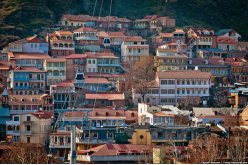 One of the Must-Dos and probably the most distinctive pleasures of visiting Tbilisi is wandering through the Old City, with its old-style balconies, ancient churches, winding, narrow streets, and charming shops. Here one will notice a number of eclectic sights – sites ranging from churches to mosques and synagogues, as well as the art galleries lining along the way. The uniqueness of attractions and the cultural as well as architectural diversity widely presented at this spot starting from Sulfur Baths, Betelmi - housing two of the city's
One of the Must-Dos and probably the most distinctive pleasures of visiting Tbilisi is wandering through the Old City, with its old-style balconies, ancient churches, winding, narrow streets, and charming shops. Here one will notice a number of eclectic sights – sites ranging from churches to mosques and synagogues, as well as the art galleries lining along the way. The uniqueness of attractions and the cultural as well as architectural diversity widely presented at this spot starting from Sulfur Baths, Betelmi - housing two of the city's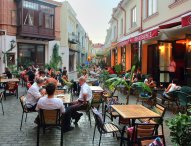 oldest churches and the stunning views from the Narikala Fortress is simply overwhelming.
oldest churches and the stunning views from the Narikala Fortress is simply overwhelming.
Old Tbilisi, with its variety of bars and restaurants, is also the nightlife hub of the city. The venues range from student bars and cafes to upscale restaurants and clubs.
Metekhi Church
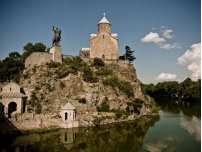 Metekhi Church was built by the Georgian king Demetre II around 1278-1284 years. It is represented as an unusual example of domed Georgian Orthodox Church although it was damaged and restored multiple times. The church is situated at the top of the hill overlooking “Abanotubani” and the river Mtkvari. During the Soviet era the church lost its religious purposes, was demolished and later in 1819 was replaced by a new building that functioned as a jail.
Metekhi Church was built by the Georgian king Demetre II around 1278-1284 years. It is represented as an unusual example of domed Georgian Orthodox Church although it was damaged and restored multiple times. The church is situated at the top of the hill overlooking “Abanotubani” and the river Mtkvari. During the Soviet era the church lost its religious purposes, was demolished and later in 1819 was replaced by a new building that functioned as a jail.
In the later part of Soviet period the church was used as a theatre. In the late 1980s Catholicos-Patriarch of all Georgia Ilia II launched a campaign of restoration of Metekhi Church which restarted functioning again in 1988. The equestrian statue of King Vakhtang Gorgasali (the founder of the city of Tbilisi) by a famous Georgian sculptor Elguja Amashukeli was hoisted in front of the church in 1961.
Sulfur Baths
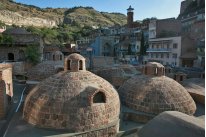 The bath district is called “Abanotubani” and is on the south side of the Metekhi Bridge. It catches one’s eye immediately with its small, brick domes on ground level. The sulfur waters are naturally warm and in a way represent the icon of the city since the well-known legend of how Tbilisi was founded is associated with the warm springs of the sulfur waters.
The bath district is called “Abanotubani” and is on the south side of the Metekhi Bridge. It catches one’s eye immediately with its small, brick domes on ground level. The sulfur waters are naturally warm and in a way represent the icon of the city since the well-known legend of how Tbilisi was founded is associated with the warm springs of the sulfur waters.
There are several small baths offering different levels of comfort. The baths are relatively small, and you may have to wait for a pool to become available. Massages are also available; however, they are more like a washing, but well worth of the authentic experience.
Narikala Fortress
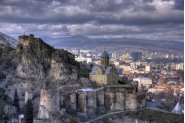 The Narikala Fortress is one of the most famous, oldest and most favoured historic sites of Tbilisi. It was established in the 4th century and was considerably expended over subsequent centuries. Much of what remains today dates from the 16th and 17th centuries. The initial name of the fortress was “Shuris-Tsikhe” (Invidious Fortress) and was later renamed by Mongols as “Naria Qala” literary translated as a “Little Fortress”.
The Narikala Fortress is one of the most famous, oldest and most favoured historic sites of Tbilisi. It was established in the 4th century and was considerably expended over subsequent centuries. Much of what remains today dates from the 16th and 17th centuries. The initial name of the fortress was “Shuris-Tsikhe” (Invidious Fortress) and was later renamed by Mongols as “Naria Qala” literary translated as a “Little Fortress”.
Narikala is situated on a steep hill between the Sulphur Baths and the Botanical Gardens of Tbilisi overlooking the city and the Kura River. Most of the castle is in ruins and the steps that lead to the top are steep and narrow, thus may not be accessible to everyone, although the view from the battlements is quite spectacular and highly appreciated by visitors. The complex consists of two parts – upper and lower sections. At the lower part of the citadel is the recently restored St. Nicholas church (built in 1996-1997 years as a replacement of the original 13th century church).
If you are unable to access this form please contact Irakli Karkashadze to book your place
Tour 2 - Mtskheta (Old Capital of Georgia)
Date: Saturday 4 July
Time: 11:00 – 16:00
Mtskheta
One of the oldest cities of Georgia is located about 20 kilometers north of Tbilisi at the confluence of the Aragvi and Mtkvari rivers. The city is considered to be one of the oldest continuously inhabited cities in the world and today is populated by around 19 500 people. The town has an extraordinary importance to the Georgian Nation as it was the capital of the eastern Georgian kingdom of Iberia from the 3rd century BC to the 5th century AD. Mtskheta was the site of Georgia’s adoption of Christianity in 334 and remains to be one of the headquarters of the Georgian Orthodox Church. Mtskheta is of primary interest to any visitor interested in Georgian history and/or Orthodox Christianity.
Due to its historical significance and numerous ancient monuments, the “Historical Monuments of Mtskheta” became a UNESCO World Heritage Site in 1994. The historic churches of Mtskheta are outstanding examples of medieval religious architecture in the Caucasus. They represent the high artistic and cultural level attained by this ancient kingdom.
Jvari Monastery
“The Church of the Holy Rood” is situated on top of the hill on the left bank of the Aragvi River. According to local history, in the early fourth century a wooden cross was erected over a pagan sanctuary on a rocky mountaintop overlooking Mtskehta, the former capital of the Georgian Kingdom of Kartli - Iberia. The construction of the cross symbolized the fall of paganism and rise of Christianity in Georgia.
In 545, a cruciform church, known as the Small Church of Jvari, was built just north of the cross. Between 586 and 605, a larger church was constructed directly above the site of the wooden cross, the base of which is still visible inside the church. Exceptional relief sculptures decorate the exterior facades of the Great Church. Their fine proportions and remarkable technique distinguished the sculptures from the earlier bas-relief carving common in the region. In 2004, the monastery was placed on the UNESCO World Heritage List as part of the “Historical Monuments of Mtskheta” and was added to the UNESCO List of World Heritage in Danger in 2009.
Svetitskhoveli
The Living Pillar Cathedral is known as the burial site of Christ’s mantle and was the site for coronation and burial of the kings of Georgia.
The Svetitskhoveli complex in the center of the town includes the 11th century cathedral, the palace and gates of the Katolicos Melchizedek from the same period, and the 18th century gates of Erekle II. The cathedral is domed and cruciform in plan. The interior was originally covered with wall paintings, but these were whitewashed over and only recently have fragments of them been revealed again. The facades are ornamented with decorative arcading which unites the separate components of the structure. Severely damaged by Tamurlaine, it was rebuilt in the 15th century; more serious alterations took place in the 1830s on the occasion of a visit to the Caucasus by Tsar Nicholas II, when richly ornamented galleries and subsidiary chapels were ruthlessly swept away.
If you are unable to access this form please contact Irakli Karkashadze to book your place


